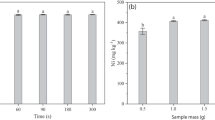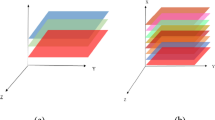Abstract
In recent years, near-infrared (NIR) hyperspectral imaging has proved its suitability for quality and safety control in the cereal sector by allowing spectroscopic images to be collected at single-kernel level, which is of great interest to cereal control laboratories. Contaminants in cereals include, inter alia, impurities such as straw, grains from other crops, and insects, as well as undesirable substances such as ergot (sclerotium of Claviceps purpurea). For the cereal sector, the presence of ergot creates a high toxicity risk for animals and humans because of its alkaloid content. A study was undertaken, in which a complete procedure for detecting ergot bodies in cereals was developed, based on their NIR spectral characteristics. These were used to build relevant decision rules based on chemometric tools and on the morphological information obtained from the NIR images. The study sought to transfer this procedure from a pilot online NIR hyperspectral imaging system at laboratory level to a NIR hyperspectral imaging system at industrial level and to validate the latter. All the analyses performed showed that the results obtained using both NIR hyperspectral imaging cameras were quite stable and repeatable. In addition, a correlation higher than 0.94 was obtained between the predicted values obtained by NIR hyperspectral imaging and those supplied by the stereo-microscopic method which is the reference method. The validation of the transferred protocol on blind samples showed that the method could identify and quantify ergot contamination, demonstrating the transferability of the method. These results were obtained on samples with an ergot concentration of 0.02 % which is less than the EC limit for cereals (intervention grains) destined for humans fixed at 0.05 %.

Pictures showing a the manual removal of ergot bodies and b the observation by the stereo-microscopic method (official method); c the metallic holder with the reference material, and d the NIR hyperspectral SisuCHEMA instrument





Similar content being viewed by others
References
Sleper DA, West CP (1996) Tall fescue. In: L.E. Moser et al. (ed) Cool-season forage grasses, 484–488
Tulasne LR (1853) Mémoire sur l’ergot des Glumacées. Ann Sci Nat 20(3):5–56
Ergot still present in many feed stuffs (2011) AllAboutFeed, Doetinchem, The Netherlands. http://www.allaboutfeed.net/news/ergot-still-present-in-many-feed-stuffs-12527.html Accessed 21May 2012
European Commission (2002) Directive 2002/32 on undesirable substances in animal feed. Off J Eur Comm L140:10–21
European Commission (1992) Regulation 689/92 fixing the procedure and conditions for the taking-over of cereals by intervention agencies. Off J Eur Comm L074:18–22
European Commission (2012) Commission recommendation 2012/154 on the monitoring of the presence of ergot alkaloids in feed and food. Off J Eur Union L77:20–21
Scott PM (2005) Ergot alkaloids—analysis. In: Management of mycotoxins in food and feeds for improving public health IARC (International Agency for Research on Cancer), Lyon, France, publications 158
Scott PM (2009) Ergot alkaloids: extent of human and animal exposure. World Mycotoxin J 2(2):141–149
Krska R, Crews C (2008) Significance, chemistry and determination of ergot alkaloids: a review. Food Addit Contam 25(6):722–731
Contaminants in food and feed: inexpensive detection for control of exposure (2008) CONffIDENCE CRA-W Gembloux, Belgium. http://www.conffidence.eu Accessed 02 May 2012
Roberts CA, Benedict HR, Hill NS, Kallenbach RL, Rottinghaus GE (2005) Determination of ergot alkaloid content in tall fescue by near-infrared spectroscopy (forage & grazing lands) (pasture grasses). Crop Sci 45:778–783
FAO (Food and Agricultural Organization of the United Nations) (2004) Worldwide regulations for mycotoxins in food and feed in 2003. FAO Food and Nutrition Paper 81. FAO, Rome
European Commission (2008) Regulation 687/2008 establishing procedures for the taking-over of cereals by intervention agencies or paying agencies and laying down methods of analysis for determining the quality of cereals. Off J Eur Comm L192:20–48
Method for the determination of ergot (Claviceps purpurea Tul.) in animal feedingstuff (2011). IAG (International Association of Feedingstuff Analysis)–Section Feedingstuff Microscopy IAG-Method Hameln, Germany. http://www.iagmicro.org/files/iag-a4_ergot.pdf. Accessed 02 May 2012
Baeten V, Dardenne P (2005) Spectrochemical analysis using infrared multichannel detectors. Blackwell Publishing Chapter 13:283–301
Fernández Pierna JA, Baeten V, Michotte Renier A, Cogdill RP, Dardenne P (2004) Combination of support vector machines (SVM) and near infrared (NIR) imaging spectroscopy for the detection of meat and bone meat (MBM) in compound feeds. J Chemom 18(7–8):341–349
Fernández Pierna JA, Dardenne P, Baeten V (2010) In-house validation of a near infrared hyperspectral imaging method for detecting processed animal proteins (PAP) in compound feed. Journal of NIRS 18:121–133
Baeten V, Fernández Pierna JA, Dardenne P (2007) Techniques and applications of hyperspectral image analysis. John Wiley & Sons, Ltd., Chichester, England. Chapter 12:289–311
Baeten V, Fernández Pierna JA, Vermeulen P, Dardenne P (2010) NIR hyperspectral imaging methods for quality and safety control of food and feed products: contributions to 4 European projects. NIR News 21(6):10–13
Vermeulen P, Fernández Pierna J, Abbas O, Dardenne P, Baeten V (2010) Applications of vibrational spectroscopy in food science authentication and traceability of agricultural and food products using vibrational spectroscopy. John Wiley & Sons Ltd., Chichester, England. 5 (2):609-630
Vermeulen P, Fernández Pierna J, Dardenne P, Baeten V (2011) Detection of ergot bodies in cereals by near infrared spectroscopy and hyperspectral near infrared imaging Proceedings of the 14th International Conference on Near Infrared Spectroscopy (ICNIRS 2009): Breaking the dawn, Bangkok–Thailand, 7-13 November 2009 : 997–1002
Vermeulen P, Fernández Pierna JA, van Egmond HP, Dardenne P, Baeten V (2012) On line detection and quantification of ergot bodies in cereals using near infrared hyperspectral imaging. Food Addit Contam 29(2):232–240
Esbensen KH, Paoletti C, Minkkinen P (2012) Representative sampling of large kernel lots. I. Theory of sampling and variographic analysis. Trends Anal Chem 32:154–164
Wise BM, Gallagher NB, Bro R, Shaver JM, Windig W, Koch RS (2006) PLS Toolbox 4.0 for use with MATLABTM Wenatchee (WA), USA Eigenvector Research Inc
Acknowledgments
This research was partly funded by the European Commission (EC) through its Seventh Framework Programme (FP7/2007–2013) and under Grant Agreement 211326: CONffIDENCE project (www.conffidence.eu). The information contained in this paper reflects the authors’ views; the EC is not liable for any use of the information contained herein. The authors wish to thank the Walloon Agricultural Research Centre (CRA-W) for financing the NIR imaging equipment, as well as the technicians who conducted the analyses, Sandrine Mauro, Nicaise Kayoka Mukendi, and Quentin Arnould (CRA-W).
Author information
Authors and Affiliations
Corresponding author
Additional information
Published in the topical collection Rapid Detection in Food and Feed with guest editors Rudolf Krska and Michel Nielen.
Rights and permissions
About this article
Cite this article
Vermeulen, P., Fernández Pierna, J.A., van Egmond, H.P. et al. Validation and transferability study of a method based on near-infrared hyperspectral imaging for the detection and quantification of ergot bodies in cereals. Anal Bioanal Chem 405, 7765–7772 (2013). https://doi.org/10.1007/s00216-013-6775-7
Received:
Revised:
Accepted:
Published:
Issue Date:
DOI: https://doi.org/10.1007/s00216-013-6775-7




